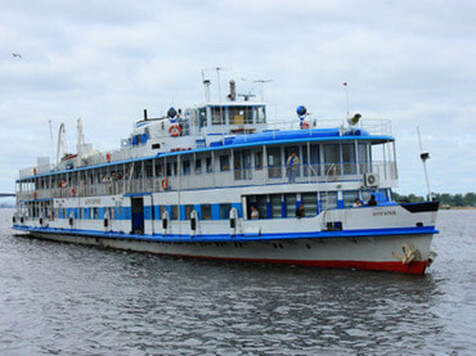Bulgaria Disaster On Volga River
By James Donahue
It began as a family pleasure cruise on Russia’s broad Volga River but when rough weather struck, one engine failed and the 56-year-old cruise ship Bulgaria took on a list, the excursion turned into a nightmare. In the end the ship turned on its side and sank, carrying 122 people, many of them children, to their deaths.
The Bulgaria was on a trip from Bulgar to Kazan in the Kansko-Ustinovsky District with over 200 passengers and crew members aboard when the disaster occurred on June 10, 2011. Of the total, 122 died.
The owners of the cruise ship, Argo Rech Tours, has since been cited for operating an overloaded vessel, operating without a permit, and operating a vessel that was malfunctioning and unseaworthy.
The master, Captain Aleksandr Ostrovsky, and his family, went down with the ship.
Survivors said the ship sank so quickly they had little time to get away. One woman told of having to break a glass window from underwater and then swim to the surface to make her escape.
An estimated 40 children and their supervisors were trapped in a children’s entertainment room at the stern of the ship. The room became their tomb.
One report said those that escaped had to fight their way out. The story said that survivors picked up by the rescue ship Arabella suffered lacerations and broken bones from breaking the windows in their cabins and squeezing through as the ship filled and sank from under them.
It was said that the Bulgaria left Bulgar with one of its two engines malfunctioning. While battling rough weather, the vessel took on a list. Captain Ostrovsky was attempting to turn his listing, underpowered vessel in choppy water in a wide portion of the Volga River in the Knybyshev Reservoir. When the waves began hitting the boat broadside, they were sweeping the decks. Then the vessel turned on its starboard side, went upside down and sank.
In addition to engine failure, the cruise was plagued by problems with its radio warning system, a lack of life-saving equipment and overcrowding. The ship was registered to carry a maximum number of 156.
By James Donahue
It began as a family pleasure cruise on Russia’s broad Volga River but when rough weather struck, one engine failed and the 56-year-old cruise ship Bulgaria took on a list, the excursion turned into a nightmare. In the end the ship turned on its side and sank, carrying 122 people, many of them children, to their deaths.
The Bulgaria was on a trip from Bulgar to Kazan in the Kansko-Ustinovsky District with over 200 passengers and crew members aboard when the disaster occurred on June 10, 2011. Of the total, 122 died.
The owners of the cruise ship, Argo Rech Tours, has since been cited for operating an overloaded vessel, operating without a permit, and operating a vessel that was malfunctioning and unseaworthy.
The master, Captain Aleksandr Ostrovsky, and his family, went down with the ship.
Survivors said the ship sank so quickly they had little time to get away. One woman told of having to break a glass window from underwater and then swim to the surface to make her escape.
An estimated 40 children and their supervisors were trapped in a children’s entertainment room at the stern of the ship. The room became their tomb.
One report said those that escaped had to fight their way out. The story said that survivors picked up by the rescue ship Arabella suffered lacerations and broken bones from breaking the windows in their cabins and squeezing through as the ship filled and sank from under them.
It was said that the Bulgaria left Bulgar with one of its two engines malfunctioning. While battling rough weather, the vessel took on a list. Captain Ostrovsky was attempting to turn his listing, underpowered vessel in choppy water in a wide portion of the Volga River in the Knybyshev Reservoir. When the waves began hitting the boat broadside, they were sweeping the decks. Then the vessel turned on its starboard side, went upside down and sank.
In addition to engine failure, the cruise was plagued by problems with its radio warning system, a lack of life-saving equipment and overcrowding. The ship was registered to carry a maximum number of 156.
